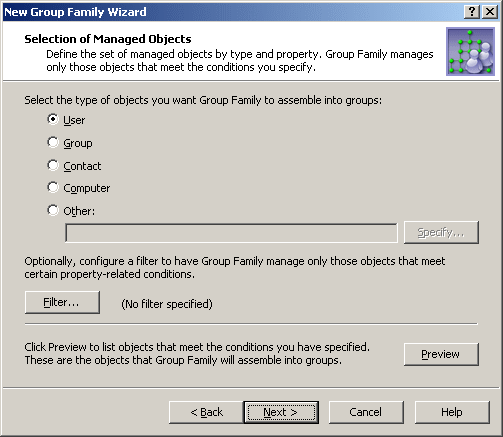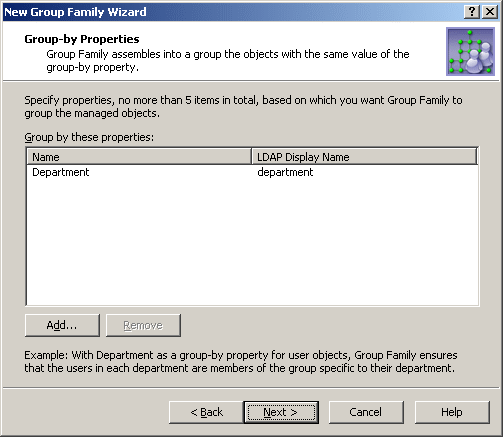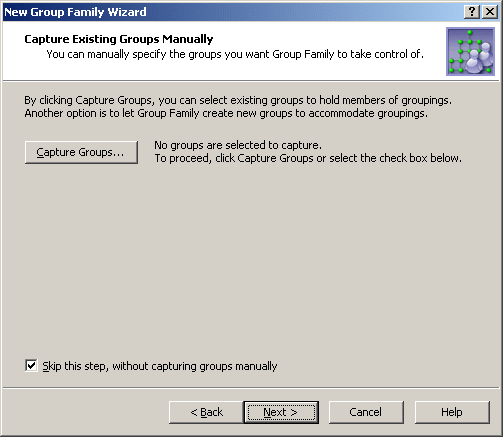The next page prompts you to specify the type of objects, such as User or Computer, to be managed by Group Family. In this way, the scope of the Group Family is limited to objects of a certain type. The scope can be further refined by applying a filter in order for the Group Family to manage only those objects that meet certain property-related conditions.
Figure 97: Selection of managed objects

You can select the type of objects you want the Group Family scope to include:
- User The Group Family scope only includes user accounts.
- Group The Group Family scope only includes groups. Note that with this option the Group Family creates groups and adds existing groups to the newly created groups.
- Contact The Group Family scope only includes contact objects.
- Computer The Group Family scope only includes computer accounts.
- Other The Group Family scope only includes the directory objects of the type you select. Click Specify and select an object type.
You have the option to further refine the Group Family scope by applying a filter. To do so, click Filter. This displays a window where you can view or modify filtering criteria. The label next to the Filter button provides a visual indication of whether any filtering criteria are specified.
In the Filter window, you can set up a list of filtering criteria, also referred to as conditions. Each condition specifies a property, operator and value, and evaluates to either TRUE or FALSE depending on the actual value of the property. For example, the following condition evaluates to TRUE for any object that has Description set to Full Time Employee:
Table 63: Filtering conditions
|
Description |
Starts with |
Full Time Employee |
If any conditions are specified, a filter is applied so that the Group Family scope only includes the objects for which all conditions evaluate to TRUE.
With an empty list of conditions, the Group Family scope includes all objects of the specified type held in the specified containers. In other words, this results in no filtering being applied.
When you apply a filter, only the objects that meet the filter conditions are added to the controlled groups. By default, no filter is applied, which causes the controlled groups to include any objects of the specified type. You can configure a basic filter by selecting properties and specifying conditions and values to search for on the selected properties.
In addition, you have the option to configure an advanced filter by entering an appropriate LDAP query. To do so, click the Advanced button in the Filter window. Note that the basic and advanced filter options are mutually exclusive. If you have applied an advanced filter, the basic filter settings are disregarded. To return to the basic filter option, click the Basic button in the Filter window—this will override the LDAP query that the advanced filter is based upon.
By clicking Preview on the Selection of Managed Objects page, you can display a list of objects currently included in the Group Family scope. The Preview window lists the objects the Group Family is going to assemble into groups.
The next page lets you set up the list of group-by properties. The Group Family breaks up the set of managed objects (scope) into groupings, each of which is comprised of the objects with the same combination of values of the specified group-by properties. For example, with Department specified as a group-by property for user objects, each grouping only includes the users from a certain department. Then, the Group Family ensures the members of each grouping belong to the group linked to that grouping.
Figure 98: Group by properties

The page lists of the currently selected group-by properties, and allows you to modify the list by adding or removing properties.
|

|
IMPORTANT: The changes you make to the list on this page reset the Group Family options that are dependent on the group-by properties. These options include the group naming rules and the list of groups to capture (see the following two sections). If you add or remove a group-by property, the current naming rules are replaced by the default naming rule and the list of groups to capture is erased. |
Group Family supports the use of multi-valued group-by properties, such as Keywords (edsvaKeywords). With Group Family configured to perform the grouping by a multi-valued property, Active Roles creates a separate group for each value of that property and populates the group with the objects whose multi-valued property in question contains the given value. Thus, by choosing edsvaKeywords as a group-by property, you can configure Group Family to create a separate group for each keyword of the objects held in a certain container. For each of those objects, Active Roles ensures that the object has membership in each of the groups corresponding to the keywords of that object. To take an example, consider a container that holds 3 objects with the following keywords:
- Object1 has Keyword1 and Keyword2
- Object2 has Keyword1 and Keyword3
- Object3 has Keyword1 and Keyword3
You can configure Group Family so that Active Roles will create 3 groups, each corresponding to one of the three keywords, and populate the groups as follows:
- Add Object1, Object2 and Object3 to the Keyword1 group
- Add Object1 to the Keyword2 group
- Add Object2 and Object3 to the Keyword3 group
The next page gives you the option to link existing groups to groupings. Normally, the Group Family automatically creates and links a group to each grouping. To override this behavior for certain groupings, you can configure the Group Family to link those groupings to the existing groups you specify.
Figure 99: Capture existing groups manually

On this page, do one of the following:
- To let the Group Family automatically create and link a group to every grouping it discovers, select the Skip this step, without capturing groups manually check box.
- To manually establish one or more group-to-grouping links, click Capture Groups.
Clicking Capture Groups displays a window where you can view or modify a list of group-to-grouping links. Each entry in the list includes the following information:
- Combination of values of the group-by properties The combination of property values that identifies a grouping.
- Group Name Identifies the group linked to the grouping.
- In Folder The canonical name of the container holding the group.
The Capture Groups window provides the following buttons for managing the list of group-to-grouping links:
- Add Opens a window where you can select a group and specify a grouping. To specify a grouping, you need to enter a certain value of each of the group-by properties. The result is that the group you select is linked to the grouping identified by the combination of values you have entered.
- Edit Allows you to modify an entry you select from the list. Opens a window where you can select a different group, or specify a different grouping by making changes to the combination of values of the group-by properties.
- Remove Deletes the links you select from the list. The result is that the Group Family will create new groups for the groupings you remove from the list.




